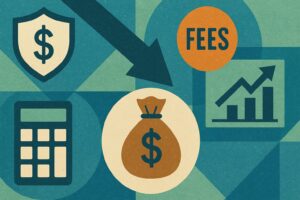Reading time: 4 minutes
Published: September 22, 2025
When it comes to investing, we often focus on returns, growth, and market trends. But what about those pesky little fees that sneak up on us like a mouse in the night? These seemingly small investment fees can quietly nibble away at your long-term returns.
Whether it’s expense ratios, advisory fees, or trading commissions, understanding these costs is crucial. Let’s explore how they can erode your investments and what you can do to keep them in check, so you can maximize your financial growth over time.

Key Takeaways
- Investment fees, though small, can significantly reduce your long-term returns.
- Different types of fees include expense ratios, advisory fees, trading commissions, and account maintenance fees.
- Choosing low-cost index funds or ETFs and negotiating advisor fees can help minimize costs.
- Compounding savings on reduced fees can greatly enhance your investment growth over time.
Understanding Investment Fees
Investment fees come in various shapes and sizes, and it’s important to recognize them. From expense ratios to advisory fees, these costs can quietly chip away at your returns. Consider expense ratios, which are the annual fees charged by mutual funds or ETFs for managing your money. They might seem small, like a harmless mosquito bite, but over time, they can bleed your returns.
Types of Investment Fees
Expense Ratios
Expense ratios are like the silent partner in your investment journey. They cover the operational costs of funds, such as management fees and administrative expenses. While they might initially appear inconsequential, imagine them as a slow leak in your financial bucket. Over decades, even a seemingly modest 1% fee can significantly erode your returns.
Advisory Fees
If you’ve ever worked with a financial advisor, you’ve likely encountered advisory fees. These fees are typically a percentage of the assets they manage for you. While an advisor can provide valuable insights, it’s wise to negotiate these fees or consider a fee-only advisor who charges by the hour or project to ensure you’re getting your money’s worth.
Trading Commissions
Every time you buy or sell an investment, you might incur a trading commission. Although many platforms now offer commission-free trading, it’s important to double-check. Frequent trading can lead to a pile of fees that might eat away at your returns like termites in a wooden house.
Account Maintenance Fees
Some accounts come with maintenance fees, which can be a flat fee or a percentage of your account balance. They might seem like a small inconvenience, but over time, they can add up. Always be on the lookout for accounts that waive these fees if certain conditions are met, such as maintaining a minimum balance.
Spotting and Reducing Fees
Now that you’re aware of the types of fees, how do you spot them? Reviewing your investment statements regularly is a good start. Look for any charges that appear under different names. Once you’ve identified them, consider strategies to reduce them. Opt for low-cost index funds or ETFs, which often have lower expense ratios compared to actively managed funds. You can also negotiate advisory fees or choose fee-free platforms to keep costs at bay.
The Power of Compounding Savings
Here’s where things get exciting: compounding savings. By minimizing fees, you’re not just saving money upfront, you’re allowing your investments to grow more efficiently over time. Imagine your investments as a snowball rolling down a hill. The less resistance it faces (in the form of fees), the bigger it becomes as it gathers more snow (returns). Keeping fees low allows your investment snowball to grow exponentially.
Strategies for Fee Reduction
Reducing investment fees is like trimming the excess fat from a steak, leaving you with the juiciest, most flavorful piece. To achieve this, consider choosing low-cost index funds or ETFs, which often have lower expense ratios. Negotiating with your advisor for a lower fee or opting for a fee-only advisor can also help. Finally, using fee-free platforms can save you from those sneaky trading commissions.
Empowering Your Investment Growth
Understanding and managing investment fees empowers you to take control of your financial journey. By keeping costs low, you’re not only maximizing your returns but also harnessing the magic of compounding. It’s like planting a seed in fertile soil watching it grow into a towering tree over time.
For more insights on maximizing your growth, check out This One Trick Can Protect Your Portfolio Long-Term.
Conclusion
Investment fees may seem like a minor inconvenience, but they can quietly undermine your long-term financial goals. By understanding the different types of fees and actively seeking ways to reduce them, you can empower yourself to maximize your investment growth.
Remember, every dollar saved on fees is a dollar that can be compounded for future growth. So, be vigilant, stay informed, and let your investments flourish without unnecessary costs weighing them down.